

Teaching Qualitative Methods Online: A Few Things That I Do. I’ve been teaching qualitative methods online since Fall 2018 – with 3 ½ semesters under my belt here are some things that I do/know!
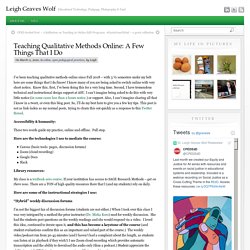
I know many of you are being asked to switch online with very short notice. Know this, first, I’ve been doing this for a very long time. Second, I have tremendous technical and instructional design support at ASU. I can’t imagine being asked to do this with very little notice (in some cases less than 2 hours notice.) or support. Also, I can’t imagine sharing all that I know in a tweet, or even this blog post. Accessibility & humanity: These two words guide my practice, online and offline. Here are the technologies I use to mediate the course: Canvas (basic tools: pages, discussion forums) Zoom (cloud recording) Google Docs Slack Library resources:
Technology in Education. By Pedro De Bruyckere, Paul A.
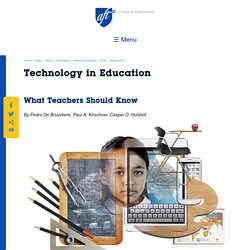
Kirschner, Casper D. Hulshof One of the most frequently cited reasons for justifying the need for change in education, or at least for labeling education as old-fashioned, is the enormous technological (r)evolution our world has undergone in recent years. Nowadays, we have the Internet in our pocket, in the form of a smartphone, which has exponentially more computing power than the Apollo Guidance Computer that put the first men on the moon! A school with desks, blackboards or whiteboards, and—perish the thought—books seems like some kind of archaic institution, one that, even if it does use a smartboard or a learning platform, operates in a manner that bears a suspiciously strong resemblance to the way things were done in the past. Shifting expectations for remote teaching… – edteki. As we come to the end of the current school year, thoughts are now turning to long range planning for possible continued disruptions at the start of the next school year.
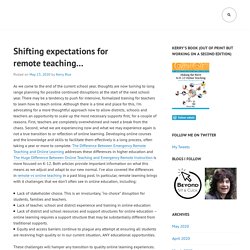
The Huge Difference Between Online Teaching and Emergency Remote Instruction. Bridging the education connectivity gap caused by the coronavirus pandemic is an important step in providing emergency remote instruction and ultimately true online teaching.
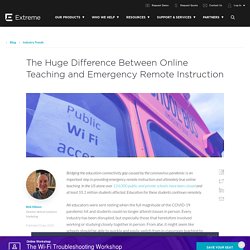
In the US alone over 124,000 public and private schools have been closed and at least 55.1 million students affected. Education for these students continues remotely. All educators were sent reeling when the full magnitude of the COVID-19 pandemic hit and students could no longer attend classes in person. Every industry has been disrupted, but especially those that heretofore involved working or studying closely together in person. From afar, it might seem like schools should be able to quickly and easily switch from in-classroom teaching to online teaching.
Indeed an early concept of distance learning goes back to the beginning of the U.S. Integrating the Science of How We Learn into Education Technology. Executive Summary For well over a century, researchers have labored tirelessly to understand how humans learn and remember.
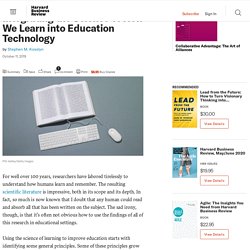
The resulting scientific literature is impressive, both in its scope and its depth. EdTech Books. The Difference Between Emergency Remote Teaching and Online Learning. Well-planned online learning experiences are meaningfully different from courses offered online in response to a crisis or disaster.
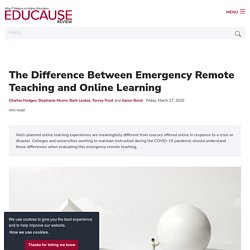
Colleges and universities working to maintain instruction during the COVID-19 pandemic should understand those differences when evaluating this emergency remote teaching. Due to the threat of COVID-19, colleges and universities are facing decisions about how to continue teaching and learning while keeping their faculty, staff, and students safe from a public health emergency that is moving fast and not well understood. Many institutions have opted to cancel all face-to-face classes, including labs and other learning experiences, and have mandated that faculty move their courses online to help prevent the spread of the virus that causes COVID-19. The list of institutions of higher education making this decision has been growing each day. Paperless is Not a Pedagogy.
Everything You Need to Know About Building a Great Screencast Video. Practical advice for instructors faced with an abrupt move to online teaching (opinion) With the possible disruption to social gatherings presented by the coronavirus, there is increased discussion around planning for the use of online learning as a continuity plan for most universities and schools.
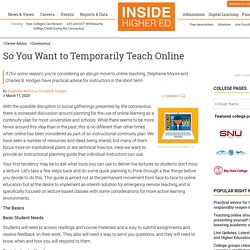
While there seems to be more fervor around this idea than in the past, this is no different than other times when online has been considered as part of an instructional continuity plan. We have seen a number of resources and ideas being shared, but many of them focus more on institutional plans or are technical how-tos. Here we want to provide an instructional planning guide that individual instructors can use. Your first tendency may be to ask what tools you can use to deliver live lectures so students don’t miss a lecture. Digital Learning: How is it Shaping our Families? - Articles - BioLogos. Technology, Learning, and Faith Armed with a more nuanced picture technology, we can ask questions that push further than “does this help get the job done?”
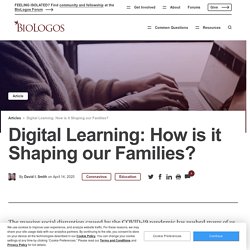
I’d like to illustrate this by touching on some examples from our research. In focus groups with parents, we heard concern about increased risk of exposure to harmful material, especially pornography. As one parent put it, “This is a perfect time in 5th grade to talk about bad things on the internet because they talk about health now and we start talking about sex. A pan-Canadian effort in online education? PD not content. – George Veletsianos, PhD. Alex Usher writes that “the only way forward [i.e the Fall semester] for [Canadian] institutions is to do something which does not come naturally to them, and that is to create a national online curriculum collaboration.”

Online learning for beginners: 1. What is online learning? Online learning for beginners: 7. Why not just record my lectures? This is the seventh in a series of a dozen blog posts aimed at those new to online learning or thinking of possibly doing it.
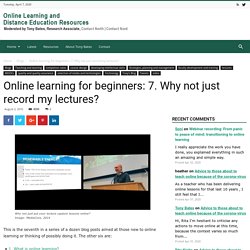
The other six are: Documentation:Design Principles for Multimedia - UBC Wiki. “It's not the specific media that creates learning, it's the educational design that creates learning.” Richard Mayer, Professor of Psychology – University of California – Santa Barbara. Overview. Quick Start: Screen Recording With Open Broadcaster Software. 1,200+ courses and ebooks Design, code, video editing, business, and much more. Adobe Photoshop, Illustrator and InDesignGraphic, Logo and Print DesignSketch, Adobe XD & FigmaWordPressJavascript, PHP & PythonAdobe After Effects & Premiere ProMuch More Millions of creative assets.